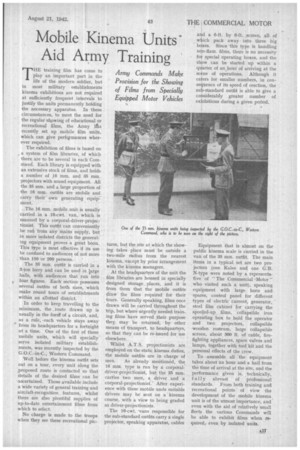Mobile Kinema Units Aid Army Training
Page 19

If you've noticed an error in this article please click here to report it so we can fix it.
Army Commands Make Provision for the Showing of Films from Specially Equipped Motor Vehicles
THE training film has come to play an important part in the life of the modern soldier, but in most military establishments kinema exhibitions are not required at sufficiently frequent intervals to justify the units permanently holding the necessary apparatus. In these circumstances, to meet the need for the regular. showing cf educational or recreational films, the Army As recently set up mobile film units, which can give perfqmances wherever required.
The exhibition of films is based on a system of film libraries, of which there are to.be several in each Command. Each library is equipped with an extensive stack of films, and holds a number of 16 mm. and 35 mm. projectors with sound equipment. All the 35 mm. and a large proportion of the 16 mm. outfits are mobile and carry their own generating equip: ment.
The 16 mm. mobile .unit is usually carried in a 10-cwt. van, which is manned by a corporal-driver-projectionist. This outfit can conveniently be run from any mains supply, but in more isolated districts the generating equipment proves a great boon. This type is most effective if its use be confined to audiences of not more than 150 or 200 persons..
The The 35 mm. outfit is carried in a 3-ton lorry and can be used in large halls, with audiences that run into four figures. Each section possesses several outfits of both sizes, which make round tours of establishments within an allotted district. '
In order to keep travelling to the minimum, the ,route drawn up is usually in the forth of a circuit, and, as a rule, . each vehicle stays away from its headquarters for a fortnight at a time. One of the first of these mobile units, which will specially serve isolated military establishments, was recently inspected by the G.O.C.-in-C., Western Command.
Well before the kinema outfit sets out on a tour, every unit along the proposed route is contacted so that details of the desired films can be ascertained. Those available include a 'wide variety of general training and airciaft-recognition features, whilst there are also plentiful supplies of up-to-date entertainment films from which to select.
No charge is made to the troops when they see these recreational pie tures, but the site at which the showing takes place must be outside a two-mile radius from the nearest kinema, except by prior arrangement with the kinema managers.
At the headquarters of the unit the film libraries are housed in specially designed storage places, and it is from them that the mobile outfits draw the films required for their tours. Generally speaking, films once drawn will be carried throughout the trip, but where urgently needed training films have served their purpose they may be returned, by other means of transport, to headquarters, so that they can be re-issued for use elsewhere. .
Whilst A.T.S. projectionists are employed on the static kinema duties, the mobile outfits are in charge of men. As already mentioned, the 16 mm. type is run by a corporaldriver-projectionist, but the 35 mm. carries two men, a driver and a corporal-projectionist.' After experience with these mobile units suitable drivers may be sent on a kinema course, with a view to being graded as driver-projectionists.
The 10-cwt. 'vans responsible for the sub-standard outfits carry a single projector, speaking apparatus, cables
and a 6-ft. by 6-ft. ,screen, all of which pack away into three big boxes. Since this type is handling non-flam. films, there is no necessity for special operating boxes, and the show can be started up within a quarter of an.,hour of arriving at the scene of operations. Although it caters for smaller numbers, in conseqUence of its speed of erection, the sub-standard outfit is able to give a considerably greater number of exhibitions during a given period.
Equipment that is almost on the public kinema scale is carried in the van of the 35 mm. outfit. The main items in a typical set are two projectors (one Kalee and one G.B. N-type were noted by a representative of "The Commercial 'Motor" who visited such a unit), speaking equipment with large horn and spares, control panel for different types of electric current, generator, steel film cabinet for carrying the spooled-up films, collapsible iron operating box to hold the operator and two projectors, collapsible wooden rostrum, large collapsible screen, about 300 ft. of cable, firefighting appliances, spare valves and lamps, together with tool kit and the personal effects of the crew.
To assemble all the equipment takes about an hour and a half from the time of arrival at the site, and the performance given is, technically, fully abreast of professional standards. From both training and recreational points of view the development of the mobile kinema unit is of the utmost importance, and even with the aid of relatively small fleets the various Commands will be able to exhibit films when reqUired, even by isolated units.




















































